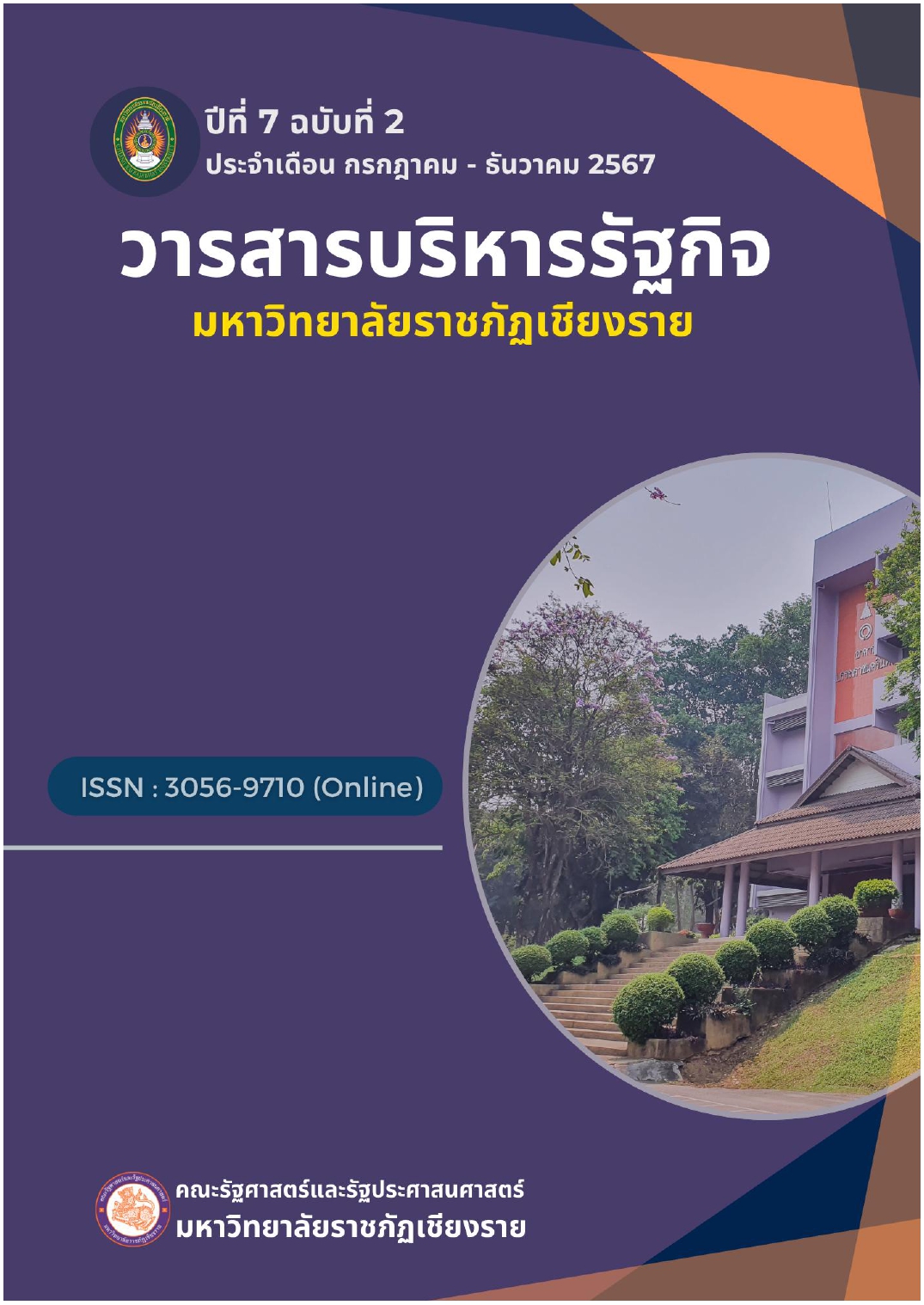Public Participation in Community-Based Tourism Management : A Case Study of Pha Mee Village, Wiang PhangKham Sub-district, Mae Sai District, Chiang Rai Province
Main Article Content
Abstract
This research aims to 1) study the level of public participation in community-based tourism management in Pha Mee Village, and 2) compare personal factors with the participation in community-based tourism management. The study employs quantitative research methods, with the population consisting of local leaders, community leaders, business operators, and General people that living in community aged 20 years and above from Pha Mee Village, Wiang Phang Kham Sub-district, Mae Sai District, Chiang Rai Province, totaling 276 people. Data were analyzed using statistical software to determine percentage, mean, standard deviation, and One – way Anova.
The findings indicate that the majority of respondents are aged between 40 – 49 years, work as farmers, have a monthly income of 10,001 – 15,000 baht, and have lived in the community for over 11 years. Most of them are general villagers. Overall, public participation in community-based tourism management is at a moderate level in three areas and at a low level in one area. The areas of participation, in descending order, are as follows: benefit-sharing, operational participation, decision-making, and evaluation participation. Hypothesis testing reveals that personal factors, such as age, occupation, income, and sample group type, significantly influence the level of public participation in tourism management. However, the length of time living in the community does not significantly affect participation levels.
Article Details
References
กุลจิรา เสาวลักษณ์จินดา. (2555). การมีส่วนร่วมของชุมชนต่อการจัดการแหล่งท่องเที่ยว: กรณีศึกษาอำเภออินทร์บุรี จังหวัดสิงห์บุรี. สารนิพนธ์บริหารธรุกิจมหาบัณฑิต. มหาวิทยาลัยเทคโนโลยีราชมงคลธัญบุรี.
จริยาภรณ์ เจริญชีพ. (2560). การมีส่วนร่วมของชุมชนในการจัดการท่องเที่ยวอย่างยั่งยืน: กรณีศึกษาตำบลถ้ำรงค์ อำเภอบานลาด จังหวัดเพชรบุรี. วารสารสารสนเทศ, 16(2), 85-97.
ชัญญานุช ยุทธวรวิทย์. (2565). การศึกษาโมเดลการจัดการการท่องเที่ยวโดยชุมชน เพื่อการพัฒนาการท่องเที่ยวอย่างยั่งยืน. สารนิพนธ์การจัดการมหาบัณฑิต. มหาวิทยาลัยมหิดล.
ชานนท์ นัยนา. (2561). การจัดการการท่องเที่ยวอย่างยั่งยืน กรณีศึกษาบางกะเจ้า. วิทยานิพนธ์รัฐศาสตรมหาบัณฑิต. มหาวิทยาลัยธรรมศาสตร์.
ณัฎฐณิชา หมื่นหนู. (2555). การมีส่วนร่วมของชุมชนในการพัฒนาการท่องเที่ยวอย่างยั่งยืน กรณีศึกษา: เทศบาลตำบลทะเลน้อยและเทศบาลพนางตุง อำเภอควนขนุน จังหวัดพัทลุง. วิทยานิพนธ์ศิลปศาสตร์มหาบัณฑิต มหาวิทยาลัยนานาชาติแสตมฟอร์ด.
ณัฐวุฒิ รัพยูร และปรารถนา หลีกภัย. (2565). ปัจจัยที่ส่งผลต่อการมีส่วนร่วมของประชาชนในการจัดการการท่องเที่ยวอุทยานธรณีสตูล. วารสารวิชาการมนุษยศาสตร์และสังคมศาสตร์มหาวิทยาลัยราชภัฏนครปฐม, 13(1), 67-83.
ธนวดี สุขขี. (2549). การมีส่วนร่วมของประชาชนในการจัดการท่องเที่ยวในเขตอำเภอเกาะสีชัง จังหวัดชลบุรี. วิทยานิพนธ์รัฐประศาสนศาสตร์มหาบัณฑิต มหาวิทยาลัยบูรพา.
ปิยธิดา ปาลรังสี และกุลพิชญ์ โภไคยอุดม. (2559). ปัจจัยที่ส่งผลต่อการมีส่วนร่วมของประชาชนในการท่องเที่ยวโดยชุมชน อำเภอขนอม จังหวัดนครศรีธรรมราช. วารสารวิทยาศาสตร์การกีฬาและสุขภาพ, 17(2), 99-110.
พรทิพย์ จุ้ยรอด. (2556). การมีส่วนร่วมของชุมชนในการพัฒนาการท่องเที่ยวเชิงอนุรักษ์บริเวณตลาดน้ำโบราณบางพลี อำเภอบางพลี จังหวัดสมุทรปราการ. วารสารร่มพฤกษ์ มหาวิทยาลัยเกริก, 31(1), 93-114.
รุ่งนภา อินภูวา และนันทวรรณ นวลักษณ์. (2562). บทบาทการมีส่วนร่วมของประชาชนในการอนุรักษ์แหล่งท่องเที่ยวเชิงวัฒนธรรม : กรณีศึกษาจังหวัดนครพนม. วารสารวิจัยรามคำแหง (มนุษยศาสตร์และสังคมศาสตร์), 22(2), 73-83.
ลีนวัตร วาลีประโคน. (2563). การมีส่วนร่วมของประชาชนในการจัดการท่องเที่ยวชุมชนในพื้นที่อำเภอประโคนชัย จังหวัดบุรีรัมย์. วิทยานิพนธ์ศึกษาศาสตรมหาบัณฑิต. มหาวิทยาลัยราชภัฏสุรินทร์.
วิภาดา มุกดา. (2557). การมีส่วนร่วมของประชาชนในการจัดการท่องเที่ยวเชิงนิเวศอำเภออุ้มผาง จังหวัดตาก. Journal of Multidisciplinary in Social Sciences (JMSS), 10(3), 55-74.
สมศักดิ์ แก้วนุช. (2567). บ้านผาหมี. สืบค้นเมื่อ 10 กันยายน 2567, จาก https://wikicom munity.sac.or.th/community/38
สุจิตรา ยางนอก, ลัญจกร นิลกาญจน์, ปัญญา เลิศไกร. (2566). การจัดการท่องเที่ยวโดยชุมชนแบบยั่งยืน. วารสารวิชาการมนุษยสังคมสาร, 21(2), 279-300.
สุพิชญา บุญคำ และวิจิตรา ศรีสอน. (2560). การมีส่วนร่วมของประชาชนในการบริหารการท่องเที่ยวเชิงวัฒนธรรมของชุมชนเชียงคาน อำเภอเชียงคาน จังหวัดเลย. วารสารวิจัยและพัฒนา มหาวิทยาลัยรายภัฏเลย, 12(40), 75-84.
สุวัช วาณิชย์วิรุฬห์ (2562). ปัจจัยที่มีผลต่อการมีส่วนร่วมของประชาชนในการจัดทำแผนแม่บท เพื่อส่งเสริมการท่องเที่ยวเชิงวัฒนธรรมของชุมชนเกาะเกร็ด อำเภอปากเกร็ด จังหวัดนนทบุรี. จันทรเกษมสาร, 25(1), 31-44.
Cohen, J. M. & Uphoff, N. T. (1980). Rural Development Participation: Concept and Measures for Project Development Committee Center for International Studies. New York: Cornell University.
Lo, Y. C., & Janta, P. (2020). Resident's perspective on developing community-based tourism - a qualitative study of Muen Ngoen Kong community, Chiang Mai, Thailand. Frontiers in Psychology, 11, 1 – 14.


